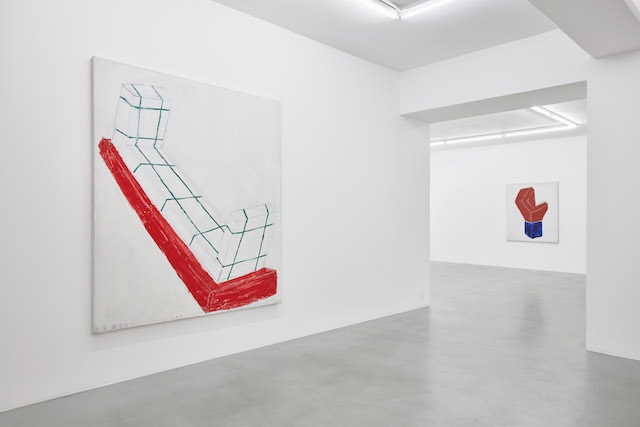That Torsten Andersson, who passed away in 2009, has not been the subject of a significant exhibition for a decade – other than the annual exhibit his foundation has organised since 2010 at his residency in Benarp, 60km northeast of Malmö – might be a legacy of his fabled eccentricity. Legend has it that when Hans Ulrich Obrist and other members of the curatorial illuminati visited his studio, they found Andersson burning all his paintings in the yard.
Rather than focusing on the cult around the person, Nordenhake’s show presents a distilled selection of works made between 1977 and 2006, following a break in production between 1966 and the mid-70s. À la Lee Lozano’s Dropout Piece (1970), Andersson withdrew from the artworld after a quarrel with the academy in Stockholm, where he worked as a professor. The painting Gravsten (Tombstone, 2005) is inspired by this experience, which left him, in his own words, ‘totally isolated, completely abandoned’. The work depicts a light blue rectangular solid on a lighter azure background, seemingly being swallowed by a wavelike, or tomblike, dark-blue shape. The structure resembles a headstone, or possibly the academy building, and carries the artist’s name, the word konstnär (artist) as well as the dates of his birth and the 1966 withdrawal.
Porträtt av en målning – Bild av skulptur (Portrait of a painting – Image of sculpture, 1980–89) follows the lineage of Joseph Kosuth’s formative conceptual installation One and Three Chairs from 1965. In Andersson’s painting, the Derridean poststructuralist conundrum of signifier and transcendental signified is explored on canvas in the form of a painting of a sculpture, with the word skulptur written on it, leaning against a sculpture – all painted.
The exhibition also features two depictions of stick sculptures, from a series titled Pinnaskulptur (both 2005–6). Abstract geometric shapes composed of red, purple, yellow, green and blue lines emerge from a white canvas. The painted outlines are traced by furrowed marks, accentuating the peculiar structures’ protrusion into the viewer’s space. Any attempt at Renaissance perspective is thwarted. These impossible objects – more illogical than any M.C. Escher staircase – are best described as delirious Mondrian structures. One of the Pinnaskulptur canvases bears the handwritten letters ‘DNA’, alluding to the shape of the threadlike chain of nucleotides, or possibly to the artist’s search for the essential building blocks of painting.
Quite different from the other works on display is the painting Kansersjuk skulptur (Kancer-sick sculpture, 2000), with the inscribed title looming beneath the upper-left edge of the canvas, purposefully misspelling the Swedish word cancersjuk. Painted on a light-yellow background is a chair with a purple upholstering that resembles a body. The contours of the fleshly furniture are smudgy, almost wavering, as if depicted in a moment of gene mutation. Andersson never had cancer, and rather than as autobiographical reference, I read the work as another comment on the nature of painting.
Several other paintings of sculptures, sockets and shelves are on view, such as Tygskulptur (Fabric sculpture, 2001–02). The latter depicts a form, resembling an overturned bench, with a red top and a white substructure covered with a grid of green lines or – as the title suggests – wrapped in a chequered fabric.
Andersson’s art is fun (yes, fun!), witty and quirky. The exhibition grants a glimpse into the eclectic work of an artist who visibly loved painting and was curious to explore it as a language. Experimentation occupies an important place in his practice, guided by painterly urgency, perhaps even impatience. Most of the canvases on view have been remounted by the gallery and estate, with piercing marks remaining from having hastily been installed by the artist with nails. They are covered with footprints; Andersson does not seem to have cared much about the pristine. For him, what counted was exploration. Stefanie Hessler
Torsten Andersson: Ny tyngdkraft, ny epok at Galerie Nordenhake, Stockholm, 14 April – 19 May
From the Summer 2018 issue of ArtReview
